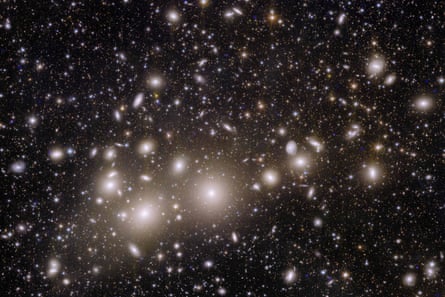The Euclid Space Telescope has beamed back its first images in a mission that promises to raise a curtain on the “dark universe”.
The €1bn (£850m) European Space Agency (Esa) mission focuses on dark matter and dark energy, which make up 95% of the universe but whose nature is almost entirely mysterious. The first images show the Perseus Galaxy Cluster and the Horsehead Nebula in stunning detail and show the telescope’s unmatched ability to capture approximately 100,000 galaxies in a single snapshot.
The telescope, which could eventually detect galaxies up to 10 billion light-years across, aims to create the largest 3D map of the universe ever created. This will allow astronomers to infer the large-scale distribution of dark matter and reveal the influence of dark energy on the early universe. Dark matter permeates the universe and acts as the cosmic glue that holds galaxies together, while dark energy is the name given to a mysterious force thought to accelerate the expansion of the universe.
Professor Carol Mundell, Esa’s science director, said the mission, launched in July, would push the boundaries of scientific knowledge “beyond Einstein” into unknown territory.

“We humans have only managed to figure out how 5% of the universe works, and we’ve also discovered that 95% is unknown to us,” he said. “We can’t probe to the edge of the universe, but we bring those images back to Earth and read them on computers – and only for 1.4 billion euros. I think it’s magical.
Over the next six years, Euclid will survey about 8 billion galaxies using infrared and visible light across 36% of the night sky. In some cases, light from these distant bodies passes close to dark matter on its journey toward Earth. When that happens, its gravitational field bends the path of light, causing galaxies to appear distorted in the final image.
“The background circular galaxy can be transformed into a banana shape,” said Professor Mark Cropper of University College London, who led the design of Euclid’s optical camera. By analyzing patterns of decay, astronomers can infer a map of dark matter distribution in the night sky and throughout the history of the universe. “You do it like toast on a toast rack,” Cropper said. “First you look at the decay of nearby galaxies and look at the dark matter in the first slice of the disc. Then you go further back to the next part—further and further out in the universe and through time.”

The work may not initially answer what dark matter is, but it should at least reveal where it is and how it works.
Researchers will also observe the motion of galaxies to create a more accurate picture of the gravitational forces that hold galaxies together, the dark energy that binds galaxies together and leads to the rapid expansion of space. This will allow scientists to see for the first time how dark energy worked in the early universe.
Mundell said: “Dark matter pulls galaxies together and makes them spin faster than visible matter; dark energy drives the universe’s rapid expansion. Euclid allows cosmologists to study these competing dark mysteries together for the first time.
René Laureijs, Esa’s Euclid project scientist, added: “We have never seen astronomical images with such detail before. They are nicer and sharper than we expected, showing us many previously unseen features in well-known parts of the nearby universe. Now we are ready to observe billions of galaxies and study their evolution over cosmic time.
